| View previous topic :: View next topic |
| Author |
Message |
Paul S

Joined: 20 Mar 2010
Posts: 79



|
 Posted: Jul 04, 2010 03:37 Post subject: Pleochroism in minerals Posted: Jul 04, 2010 03:37 Post subject: Pleochroism in minerals |
|
|
Someone asked my recently to analyze some synthetic crystals on pleochroism. He didn't have a proper microscope & camera setup, so he asked me to have a look at them. I needed to build a custom filter holder to hold two polarization filters, one below and one above the object.
Pleochroism is the effect obtained by sending polarized light through a crystal. This light gets absorbed differently along its path through the crystal, depending on the angle of the polarized light. With unpolarized light, all of these paths are combined and will show its 'normal' color. Polarized light works as a color filter, only selecting specific colors from the total amount of colors produced by the crystal. It can be tested very easily with one has an LCD screen nearby. These send out polarized light, so holding a specimen in front of it and turning it around will result in a color change. Because there is much light from the environment, the effect will be subtle.
I observed pleochroism in the synthetic crystals, but I also tried various translucent mineral specimens. I have observed pleochroism only in one of my tourmaline specimens so far (see the photos below). Photo 1 is slightly blue, because the blue component of the color has not been filtered out as in photo 2.
Has anyone else worked with pleochroism before? If so, what other species show this behavior as well?
| Description: |
| Tourmaline with normal lighting. |
|
| Viewed: |
55862 Time(s) |
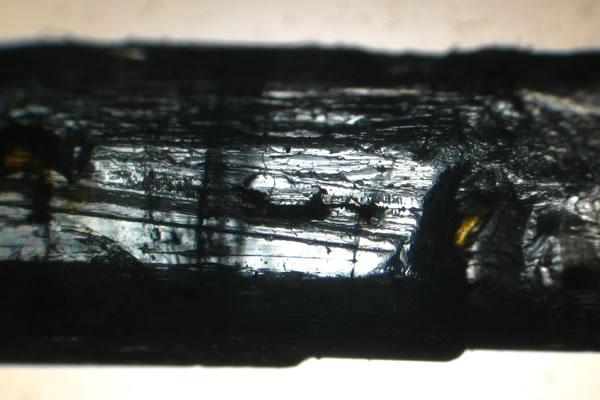
|
| Description: |
| Tourmaline with polarized lighting at a 90 degree angle compared to photo 3. |
|
| Viewed: |
55875 Time(s) |
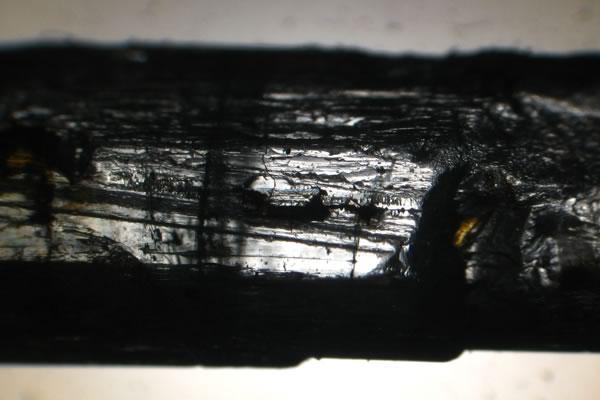
|
| Description: |
| Tourmaline with polarized lighting at a 90 degree angle compared to photo 2. |
|
| Viewed: |
55939 Time(s) |
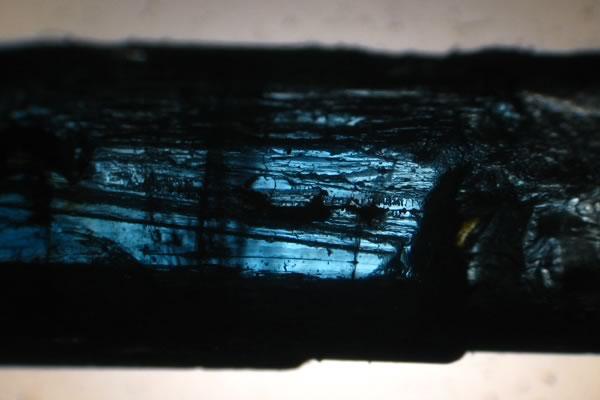
|
|
|
| Back to top |
|
 |
Vinoterapia
Joined: 03 Feb 2009
Posts: 181
Location: Houston, Tx



|
 Posted: Jul 04, 2010 05:01 Post subject: Re: Pleochroism in minerals Posted: Jul 04, 2010 05:01 Post subject: Re: Pleochroism in minerals |
|
|
Hi Paul.
If you use two polarizers, one below and one above the sample, you will not observe pleochroism but interference colors (assuming the direction of vibration of the polarizers are perpendicular to each other).
A petrographic microscope have a lower polarizer that is always in the light path going into the sample, thus provide a light beam that vibrates in just one plane, this is known as plane light. Pleochoism can be observed under this situation, by rotating the sample being illuminated by the light coming through the lower polarizer only.
Pleochroism is a characteristic of quite a number of minerals. You could find many of them by reading through any Optical Mineralogy book.
Best regards.
José Luis.
|
|
| Back to top |
|
 |
Paul S

Joined: 20 Mar 2010
Posts: 79



|
 Posted: Jul 04, 2010 05:51 Post subject: Re: Pleochroism in minerals Posted: Jul 04, 2010 05:51 Post subject: Re: Pleochroism in minerals |
|
|
You are absolutely right that pleochroism only requires one filter instead of two. I have used a single filter for studying the minerals, but the system I build can contain both filters to observe the interference colors. This can give very nice pictures, especially when used on very thin crystals.
Because I don't have the equipment to make very thin slices of mineral specimens, I make the thin crystals myself. They can easily be grown on a glass slide from a solution and can give pictures like the one below. These chemicals did not show any pleochroism though. Photo 2 is a photo of the chemicals I had to analyze in the first place. It’s easy to see that it’s a dichroic effect, showing two colors: red and yellow. In normal light the crystals appear as a dark orange.
Thanks for the literature hint, I will see if I can find some interesting books about the topic.
| Description: |
| Red prussiate crystals, with interference colors. |
|
| Viewed: |
55887 Time(s) |
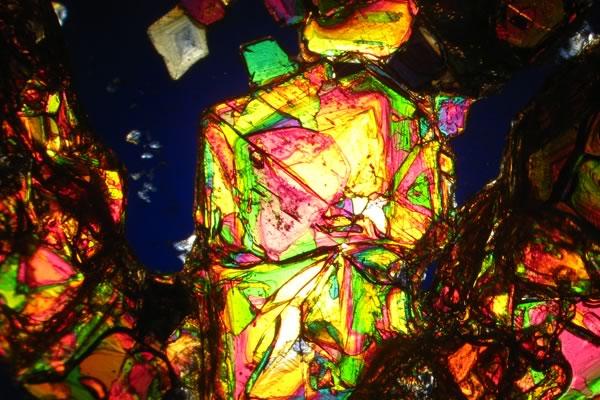
|
| Description: |
| Manganese molybdate with the two dichroic colors, red and yellow. |
|
| Viewed: |
55884 Time(s) |
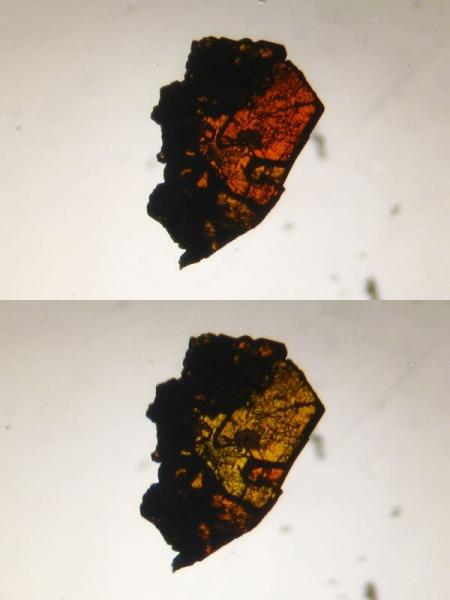
|
|
|
| Back to top |
|
 |
Peter Megaw
Site Admin

Joined: 13 Jan 2007
Posts: 975
Location: Tucson, Arizona



|
 Posted: Jul 04, 2010 07:10 Post subject: Re: Pleochroism in minerals Posted: Jul 04, 2010 07:10 Post subject: Re: Pleochroism in minerals |
|
|
Pleochroism is very easily seen in ordinary light in tanzanite (zoisite). If untreated it will show a strongly different color down each axis of the crystal ...and different orientations of a cut stone. Untreated tanzanite is usually cut so the best blue color shows through the top of the stone...but looking at the sides of the stone it may look gray. Heat treating eliminates or minimizes the pleochroism so a stone showing the same color in every direction is not natural.
Pleochroism is very useful for determining the crystallography of a mineral or mineral grain. Dichroic minerals are either hexagonal or tetragonal, and trichroic minerals are orthorhombic, monoclinic or triclinic. Isometric minerals cannot be pleochroic.
_________________
Siempre Adelante! |
|
| Back to top |
|
 |
Jesse Fisher

Joined: 18 Mar 2009
Posts: 639
Location: San Francisco



|
 Posted: Jul 04, 2010 13:38 Post subject: Re: Pleochroism in minerals Posted: Jul 04, 2010 13:38 Post subject: Re: Pleochroism in minerals |
|
|
There are a number of minerals, familiar to most collectors, that will show strong pleochrosim in reasonable transparent crystals. These include members of the epidote-zoisite group, cordierite (illoite), and the tourmaline group. It is easy to see this effect, aided by a pair of polarizing sunglasses, something which I discovered years ago when picking through the dump at the Himalaya mine for bits of tourmaline while wearing a pair of them.
Below is are two photos of a Himalaya Mine tourmaline crystal taken with a polarizing filter on the camera lens, and rotated 90 degrees between the two.
| Description: |
| pleochrosim in Himalaya Mine tourmaline |
|
| Viewed: |
55822 Time(s) |
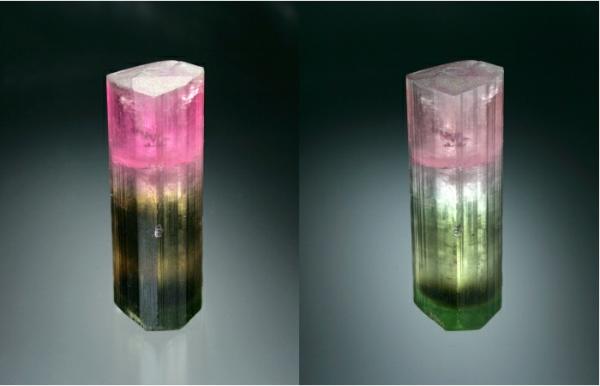
|
|
|
| Back to top |
|
 |
alfredo
Site Admin

Joined: 30 Jan 2008
Posts: 1014



|
 Posted: Jul 04, 2010 13:56 Post subject: Re: Pleochroism in minerals Posted: Jul 04, 2010 13:56 Post subject: Re: Pleochroism in minerals |
|
|
| To Jesse's list of strongly pleochroic minerals, let's add the axinite group and osumilite group. Even amethyst shows pleochroism, violet to blue, although not so pronounced, but easy to see in ametrine slices.
|
|
| Back to top |
|
 |
Elise

Joined: 22 Dec 2009
Posts: 243
Location: New York State



|
 Posted: Jul 04, 2010 14:01 Post subject: Re: Pleochroism in minerals Posted: Jul 04, 2010 14:01 Post subject: Re: Pleochroism in minerals |
|
|
| Jesse Fisher wrote: | | There are a number of minerals, familiar to most collectors, that will show strong pleochrosim in reasonable transparent crystals. These include members of the epidote-zoisite group, cordierite (illoite), and the tourmaline group.. |
Just a link back to your wonderful picture of the iolite cubes https://www.mineral-forum.com/message-board/viewtopic.php?p=10293&highlight=#10293
On that same thread there is a picture of axinite's strong pleochroism which you might add to the list of minerals with eye visible pleochroism. It is a pretty fascinating subject to study in conjunction with the different factors causing color in a particular mineral (there are are some notes on this page that go into more detail:
https://www.nordskip.com/pleochroism.html
(link normalized by FMF)
for anyone interested).
_________________
Elise Skalwold |
|
| Back to top |
|
 |
Matt_Zukowski
Site Admin
Joined: 10 Apr 2009
Posts: 737
Location: Alaska



|
 Posted: Jul 04, 2010 16:26 Post subject: Re: Pleochroism in minerals Posted: Jul 04, 2010 16:26 Post subject: Re: Pleochroism in minerals |
|
|
This brings up a question, I have always thought of spodumene as strongly pleochroic. But mindat does not list pleochroism in its optical properties like it does for epidote and cordierite.
Furthermore, I think of spodumene as being dichroic. But it is monoclinic, and Peter indicated that when pleochroic, a monoclinic xtal should be trichroic.
Is spodumene pleochroic?
|
|
| Back to top |
|
 |
Gerhard Niklasch
Joined: 27 Mar 2009
Posts: 134
Location: Munich



|
 Posted: Jul 04, 2010 16:31 Post subject: Re: Pleochroism in minerals Posted: Jul 04, 2010 16:31 Post subject: Re: Pleochroism in minerals |
|
|
The smallest item I carried home from SMaM this year was a little Uvite (~3.5mm tall and across) from Brumado, Bahia, Brazil, on Magnesite (with Woodhouseite), which is neatly dichroic: pale green in transmitted light when viewed sideways through the prism faces, purplish when viewed parallel to the c axis. With thanks to Luis Menezes for having brought along several of these striking specimens.
No polarizing filters used here - just light passing through the crystal in different directions.
--Don't know about Spodumene; but two of the three hues of a trichroic species might be very similar to each other, resulting in a superficially dichroic appearance.
| Description: |
| Side view on the left, view along the c axis on the right. (Not a stereo pair, for once!) |
|
| Viewed: |
55786 Time(s) |
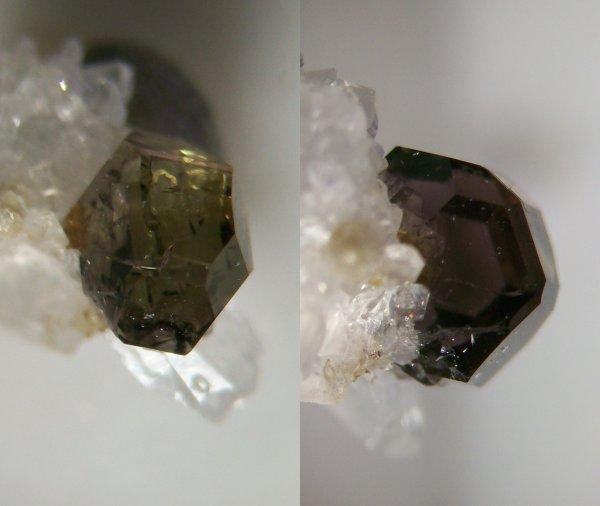
|
| Description: |
| I couldn't resist a small (untreated) Tanzanite either (found at the Mawingu Gems stall)... Here's a composite of three views, roughly along each axis. The main crystal in this group is just under 12mm tall. Note the colored shadows from light passing at a large angle to the viewing direction, too! |
|
| Viewed: |
55749 Time(s) |

|
|
|
| Back to top |
|
 |
Paul S

Joined: 20 Mar 2010
Posts: 79



|
 Posted: Jul 04, 2010 16:49 Post subject: Re: Pleochroism in minerals Posted: Jul 04, 2010 16:49 Post subject: Re: Pleochroism in minerals |
|
|
These are some very nice examples, and I can verify that amethyst shows pleochroism. It is hard to spot though and only a few crystals in a cluster might show it. It's possible that thin slices show the effect more clearly, but it is possible to find it in whole crystals. It did however not turn from violet to blue, but more from pink to dark violet. Maybe it was not pleochroism in the first place?
Regarding spodumene, I just checked my spodumene specimen, but it didn't show any pleochroism. It is however a clear specimen, so it is possible that pleochroism is present in the colored versions of the mineral.
|
|
| Back to top |
|
 |
Elise

Joined: 22 Dec 2009
Posts: 243
Location: New York State



|
 Posted: Jul 04, 2010 17:21 Post subject: Re: Pleochroism in minerals Posted: Jul 04, 2010 17:21 Post subject: Re: Pleochroism in minerals |
|
|
| Matt_Zukowski wrote: | Furthermore, I think of spodumene as being dichroic. But it is monoclinic, and Peter indicated that when pleochroic, a monoclinic xtal should be trichroic.
Is spodumene pleochroic? |
Hi- the really saturated "pinkish purple" variety is pinkish purple (alpha), pale pink (beta), and colorless (gamma). The pale pink is really hard to see, but it is there and can be seen better contrasted next to the colorless ray. Without a dichroscope or two pieces of polarizing sheets next to each other, I don't think you would see it at all. Without splitting the rays, you can see eye visible pleochroism, but only two shades (similar to andalusite where there are three colors but you only see the red and yellow as eye visible without a filter).
In the green variety of spodumene, of which I've only seen pretty light colored pieces, you can still see bluish-green (alpha), green (beta) and yellowish-green (gamma).
Cheers!
Elise
_________________
Elise Skalwold |
|
| Back to top |
|
 |
Luiz Menezes
Joined: 10 Dec 2009
Posts: 140
Location: Belo Horizonte


|
 Posted: Jul 04, 2010 18:21 Post subject: Re: Pleochroism in minerals Posted: Jul 04, 2010 18:21 Post subject: Re: Pleochroism in minerals |
|
|
Gerhard, I apologize for not recognizing you when you bought that small but nice specimen of uvite showing the strong purple/green pleochroism; it was from a small find at Brumado (July 2008).
To my knowledge all colored minerals, except the few ones that crystallize on the cubic system, are pleochroic, but on the great majority there is only a small difference on the tonality of the color depending on the direction from which the crystal is viewed; on the 1960's and 70's we had in São Paulo a mineralogy club where we had a small dycroscope that contained 2 calcite sections, at different crystal orientations, placed side by side, and we could see directly on these 2 calcite "windows" both color tonalities on all colored non-cubic crystals.
On gem rough material the pleochroism may pose a dillema for the cutters: on many minerals (like red tourmaline) the most desirable red shade is seen perpendicular to the c-axis, but because the crystals are normally thin and long, to get this best color the table of the cut stone should be positioned perpendicular to the C-axis, resulting in smaller stones than those that would be obtained by placing the table parallel to that axis, but by doing that a less valuable purplish-red or brownish-red color will show-up; if the color difference is just subtle the decision will be to cut a larger stone
even with a slightly poorer color.
I am not sure about the case of kunzite. I will try to contact Dilermando Melo, the owner of Urucum mine, where some the world's best kunzites were found on the great find of August 1998; he is still cutting kunzite rough of top quality from that pocket, I will ask him how strong is the pleochroism on that material
Luiz
|
|
| Back to top |
|
 |
John S. White
Site Admin

Joined: 04 Sep 2006
Posts: 1298
Location: Stewartstown, Pennsylvania, USA



|
 Posted: Jul 05, 2010 04:38 Post subject: Re: Pleochroism in minerals Posted: Jul 05, 2010 04:38 Post subject: Re: Pleochroism in minerals |
|
|
The Smithsonian Institution has a great spodumene (kunzite) crystal from the Urucupa mine, Itambacuri, Minas Gerais, Brazil. Photos of the three different pleochroic colors it displays appeared on the cover of Mineralogical Record, November/December 1974. When viewed normal to the long direction, it is either lilac or green depending on which side is facing you and when viewed from the top or bottom it is magenta. The crystal is perfectly transparent and measures 31 cm in length.
_________________
John S. White
aka Rondinaire |
|
| Back to top |
|
 |
Vinoterapia
Joined: 03 Feb 2009
Posts: 181
Location: Houston, Tx



|
 Posted: Jul 05, 2010 06:11 Post subject: Re: Pleochroism in minerals Posted: Jul 05, 2010 06:11 Post subject: Re: Pleochroism in minerals |
|
|
Regarding to pleochroism in Spodumene Nesse (2004), "Introduction to Optical Mineralogy" reads: "The dark-colored gem varieties are pleochroic in shades of green or lilac."
Regards.
José Luis
|
|
| Back to top |
|
 |
Elise

Joined: 22 Dec 2009
Posts: 243
Location: New York State



|
 Posted: Jul 05, 2010 08:50 Post subject: Re: Pleochroism in minerals Posted: Jul 05, 2010 08:50 Post subject: Re: Pleochroism in minerals |
|
|
| John S. White wrote: | | Photos of the three different pleochroic colors it displays appeared on the cover of Mineralogical Record, November/December 1974. When viewed normal to the long direction, it is either lilac or green depending on which side is facing you and when viewed from the top or bottom it is magenta. |
Nice photo credit too ! I wonder if the green is in the same direction as the colorless in the kunzite spodumene example I gave above. In yellow zoisite, I was amazed when I found the pleochroic colors to be orangy yellow, greenish blue and pale pink...just didn't seem possible given the combined color! To see that green in your images of the spodumene seems just as shocking, especially when it is eye visible. In a bluish green zoisite I found reddish orange, bluish green and yellowsh green and in pink zoisite - yellow, deep pink and pale pink. I've always been able to find the 3rd color in heated tanzanite zoisite using a dichroscope, though they are not consistent across different specimens, though usually some combination of purplish red, bluish violet, and bluish green (or greenish blue). Those are all just subjective color descriptions, but just to say that the colors contrasted dramatically.
Cheers!
Elise
_________________
Elise Skalwold |
|
| Back to top |
|
 |
|




